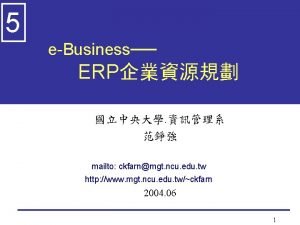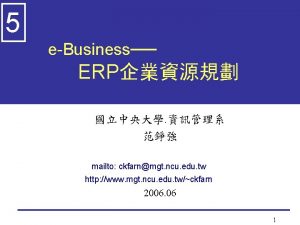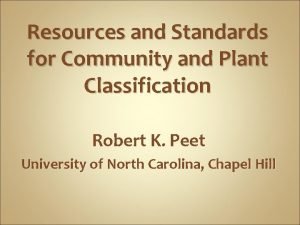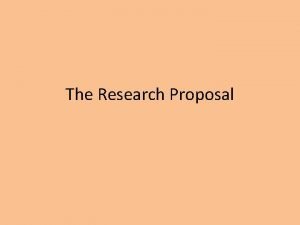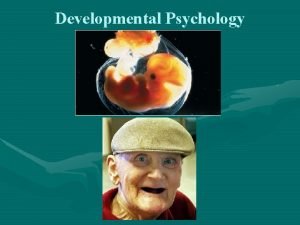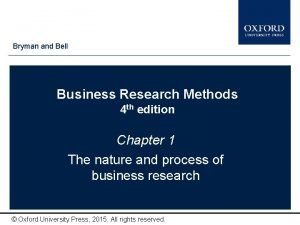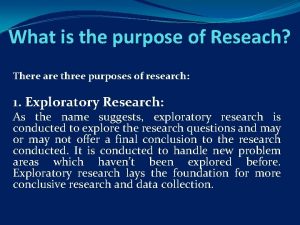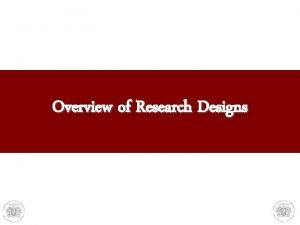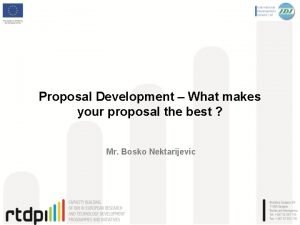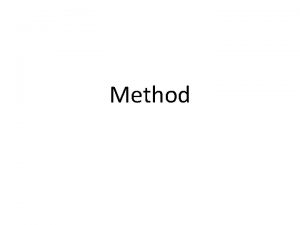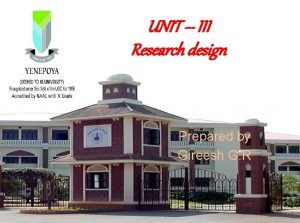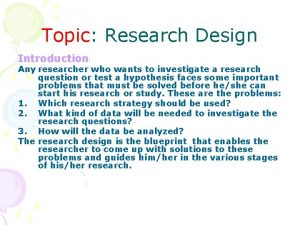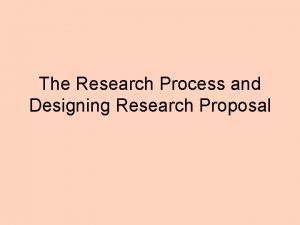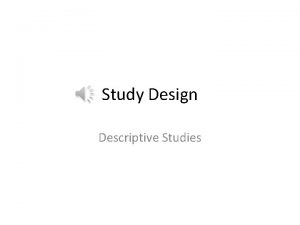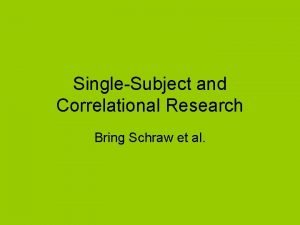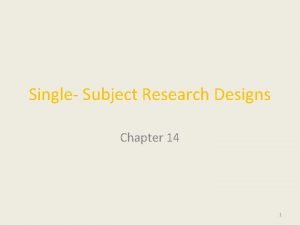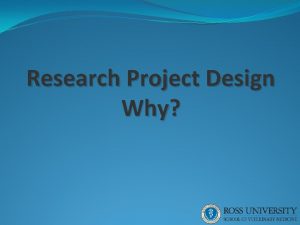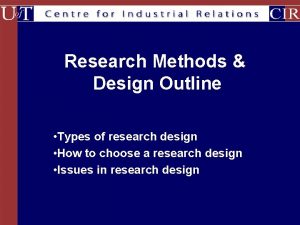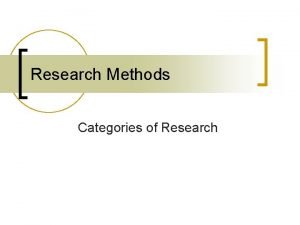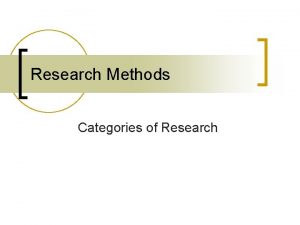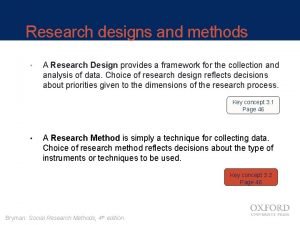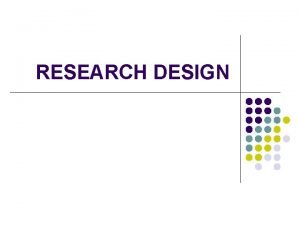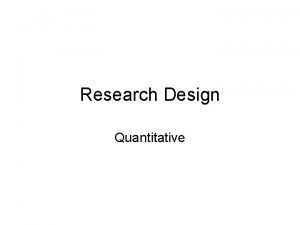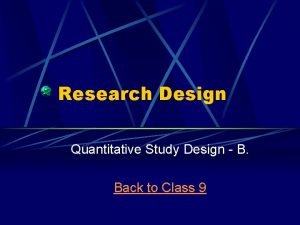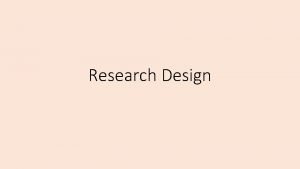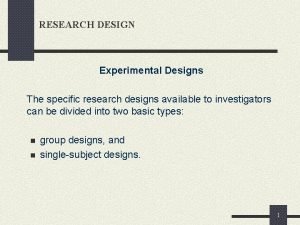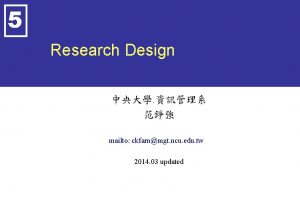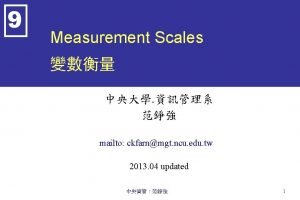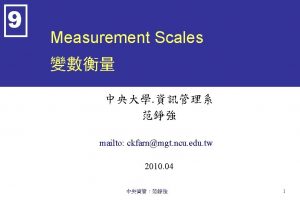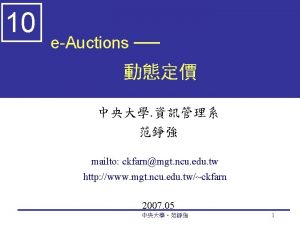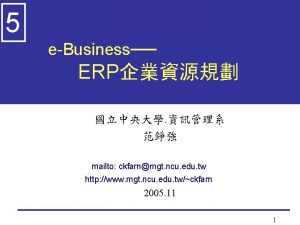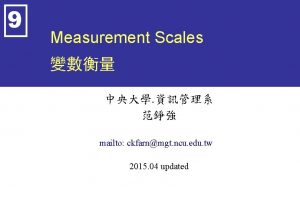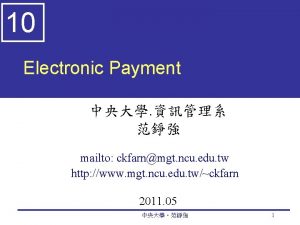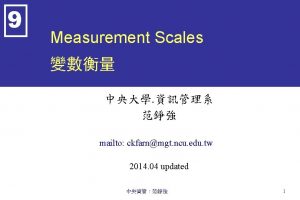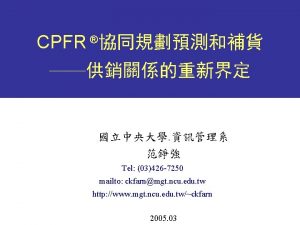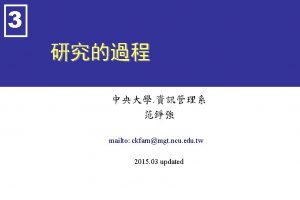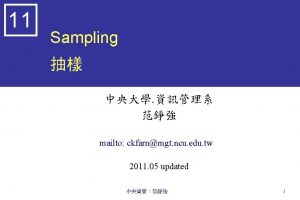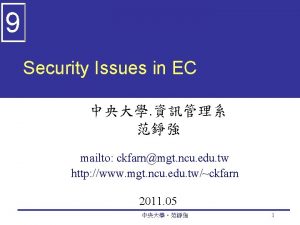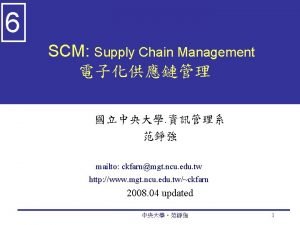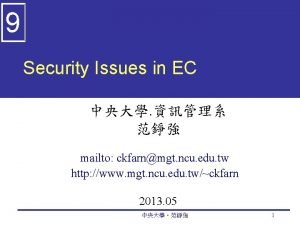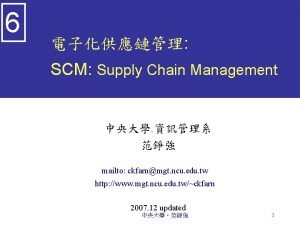5 Research Design mailto ckfarnmgt ncu edu tw
















































- Slides: 48

5 Research Design 中央大學. 資訊管理系 范錚強 mailto: ckfarn@mgt. ncu. edu. tw 2013. 03 updated

What Is Research Design? Blueprint Plan Guide Framework 中央資管:范錚強 2

What Tools Are Used in Designing Research? 有些事可以平行作業 中央資管:范錚強 3

What Tools Are Used in Designing Research? Project Plan in Gantt chart format 中央資管:范錚強 4

Descriptors of Research Design Perceptual Awareness Purpose of Study Research Environment Question Crystallization Descriptors Topical Scope 中央資管:范錚強 Data Collection Method Experimental Effects Time Dimension 5

Degree of Question Crystallization Exploratory Study Loose structure Expand understanding Provide insight Develop hypotheses 中央資管:范錚強 6


Degree of Question Crystallization Exploratory Study Formal Study Loose structure Precise procedures Expand understanding Begins with hypotheses Provide insight Answers research questions Develop hypotheses 中央資管:范錚強 8


Approaches for Exploratory Investigations Participant observation Film, photographs Projective techniques Psychological testing Case studies Ethnography 民俗誌 Expert interviews Document analysis Proxemics and Kinesics 肢體 語言學 中央資管:范錚強 10

Desired Outcomes of Exploratory Studies Established range and scope of possible management decisions Established major dimensions of research task Defined a set of subsidiary questions that can guide research design 尋找規則 Law 和初步檢視可能的原因 中央資管:范錚強 11

Desired Outcomes of Exploratory Studies (cont. ) Developed hypotheses about possible causes of management dilemma Learned which hypotheses can be safely ignored Concluded additional research is not needed or not feasible 中央資管:范錚強 12

Commonly Used Exploratory Techniques Secondary Data Analysis Experience Surveys Focus Groups 中央資管:范錚強 13

Experience Surveys What is being done? What has been tried in the past with or without success? How have things changed? Who is involved in the decisions? What problem areas can be seen? Whom can we count on to assist or participate in the research? 中央資管:范錚強 14

Focus Group discussion 6 -10 participants Moderator-led 90 minutes-2 hours 中央資管:范錚強 15



The Topical Scope Statistical Study Case Study Breadth Depth Population inferences Detail Quantitative Qualitative Generalizable findings Multiple sources of information 陷阱:整合採取兩個方法的短處 統計分析缺乏廣度 個案分析缺乏深度 中央資管:范錚強 18

The Research Environment Field conditions Lab conditions Simulations 中央資管:范錚強 19

Purpose of the Study Reporting Descriptive Casual Explanatory Causal Predictive 中央資管:范錚強 20

Descriptive Studies Who? How much? What? When? Where? 中央資管:范錚強 21

Descriptive Studies Descriptions of population characteristics Estimates of frequency of characteristics Discovery of associations among variables 樣本代表性極端重要 中央資管:范錚強 22

Experimental Effects Ex Post Facto Study Experiment After-the-fact report on what happened to the measured variable 事後回溯 Study involving the manipulation or control of one or more variables to determine the effect on another variable 可操弄、控制 中央資管:范錚強 23

Ex Post Facto Design Fishing Club Member Non-Fishing-Club Member Age High Absentee Low Absentee Under 30 years 36 6 30 48 30 to 45 4 4 35 117 45 and over 0 0 5 115 中央資管:范錚強 24

Causation and Experimental Design Control/ Matching Random Assignment 中央資管:范錚強 25

Causal Studies Symmetrical Z X Z Y Reciprocal X Y Y X Asymmetrical X Y 中央資管:范錚強 26

Understanding Casual Relationships Property Behavior Response Disposition 中央資管:范錚強 Stimulus 27

Asymmetrical Casual Relationships Stimulus-Response Property. Disposition Property. Behavior Disposition-Behavior 中央資管:范錚強 28

Fishbein & Ajzen 的 TRA Aijen and Fishbein: TRA Theory of Reasoned Actions 慎思行動理論 Belief attitute intention behavior 哪個是哪個? Stimulus: 刺激 Property: 性質(人口變數、個人特質等) Disposition: 態度、選擇、傾向 Behavior: 行為 中央資管:范錚強 29

Exhibit 6 -6 Types of Asymmetrical Causal Relationships Relationship Type Nature of Relationship Examples Stimulus-response An event or change results in a response from some object. • A change in work rules leads to a higher level of worker output. • A change in government economic policy restricts corporate financial decisions. • A price increase results in fewer unit sales. Property-disposition An existing property causes a disposition. • Age and attitudes about saving. • Gender attitudes toward social issues. • Social class and opinions about taxation. Disposition-behavior A disposition causes a specific behavior. • Opinions about a brand its purchase. • Job satisfaction and work output. • Moral values and tax cheating. Property-behavior An existing property causes a specific behavior. • Stage of the family life cycle and purchases of furniture. • Social class and family savings patterns. • Age and sports participation. 中央資管:范錚強 30

Evidence of Causality Covariation between A and B Time order of events No other possible causes of B 中央資管:范錚強 31

Participants’ Perceptional Awareness No deviation perceived Deviations perceived as unrelated Deviations perceived as researcher-induced 中央資管:范錚強 32
















 Ncú
Ncú Ncu.erp
Ncu.erp Ncu uniform
Ncu uniform Ncu erp
Ncu erp Ncu uniform
Ncu uniform Edu.sharif.edu
Edu.sharif.edu Research methodology
Research methodology Appendices sample
Appendices sample Quantitative vs qualitative
Quantitative vs qualitative Exploratory research design meaning
Exploratory research design meaning Research design for qualitative research
Research design for qualitative research Research report vs research proposal
Research report vs research proposal Conclusive research design definition
Conclusive research design definition Define pure research
Define pure research Research plan
Research plan Contrast applied research and basic research
Contrast applied research and basic research Problem definition in research
Problem definition in research Research paradigm example
Research paradigm example Operational thought
Operational thought Correlational vs comparative research
Correlational vs comparative research Components of research methodology
Components of research methodology Applied vs fundamental research
Applied vs fundamental research Basic research vs applied research
Basic research vs applied research Define reseach
Define reseach What is inquiry in practical research 2
What is inquiry in practical research 2 Characteristics of descriptive research
Characteristics of descriptive research Examples of research objectives in a research proposal
Examples of research objectives in a research proposal Research instrument in experimental research
Research instrument in experimental research Characteristics of experimental research design
Characteristics of experimental research design Longitudinal research design example
Longitudinal research design example Stanford prison experiment cells
Stanford prison experiment cells Preparing for research design
Preparing for research design Cross sectional research design example
Cross sectional research design example Correlational studies
Correlational studies Single subject research design examples
Single subject research design examples Project design in research
Project design in research Research design in clinical psychology
Research design in clinical psychology Outline research design
Outline research design Objectives of a research paper
Objectives of a research paper Categories of research design
Categories of research design Types of study design
Types of study design Example of experiment research
Example of experiment research Symbolic representation in research
Symbolic representation in research Research design descriptive quantitative
Research design descriptive quantitative Bad research questions
Bad research questions Meaning of research design
Meaning of research design Research design formulation
Research design formulation Research design methods
Research design methods Characteristics of historical research
Characteristics of historical research

